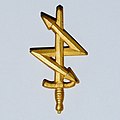| Uppland Regiment | |
|---|---|
| Upplands regemente | |
 | |
| Active | 1902–2006 |
| Country | |
| Allegiance | Swedish Armed Forces |
| Branch | Swedish Army |
| Type | Signal |
| Size | Regiment |
| Part of | IV Army Division (1902–1927) Eastern Army Division (1928–1936) IV Army Division (1937–1942) IV Military District (1942–1966) Eastern Military District (1966–1991) Middle Military District (1991–2000) SWAFHQ (2000-2006) |
| Garrison/HQ | Enköping |
| Motto(s) | Här finns inga omöjligheter ("There are no impossibilities here") |
| Colors | Red and yellow |
| March | "Utgångsmarsch" (Bergström) [note 1] |
| Battle honours | Varberg (1565), Narva (1581), Lützen (1632), Warszawa (1656), Frederiksodde (1657), March Across the Belts (1658), Rügen (1678), Düna (1701), Kliszow (1702), Holovczyn (1708), Helsingborg (1710), Svensksund (1790) |
| Insignia | |
| Branch insignia |  |
| Cap badge |  |
| Unit insignia m/1960 |  |
The Uppland Regiment (Swedish : Upplands regemente), designations Ing 3, S 1 and S 1/Fo 47, was a Swedish Army signal regiment that traced its origins back to the 19th century. It was disbanded in 2006. The regiment was garrisoned in Uppland.




